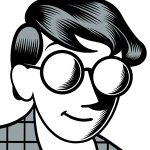When Understanding Comics, Scott McCloud’s first book and the first book to explicitly theorize comics in the medium of comics, came out, in 1993, it offered the following working definition of comics: “Juxtaposed pictorial and other images in deliberate sequence, intended to convey information and/or produce an aesthetic response in the reader.” However bulky, McCloud’s definition set the terms of debate—which is ongoing—for the field of comics: what it is, what it can do.
Reinventing Comics, McCloud’s second book, came out in 2000, and focused on the relationship of digital technology to comics. His most recent work, Making Comics, was published in September 2006, and is taking him on a year long book tour. Rounding out a trilogy, Making Comics trades none of the sophistication of McCloud’s earlier work in framing itself as a practical guide.
While a recent press release named him “the grandfather of comics,” McCloud is only forty-six (he did, however, go out of his way to draw himself thicker, and with graying temples, this time around). I sat down with McCloud in the fall of 2006, in Manhattan, previous to a book signing at Midtown Comics, and later spoke to him again by phone as he was dining with his wife and daughters at a Cracker Barrel in Springfield, Massachusetts (a circumstance which prompted polite interjections like “Excuse me, sorry, I’m stuffing my face with a biscuit,” and “Hold on, I’m taking one last swig of this Dr Pepper”).
—Hillary Chute
I. NONFICTION COMICS
THE BELIEVER: How did you get interested in comics?
SCOTT McCLOUD: In junior high school I met a kid named Kurt Busiek, who these days is known for his own comics writing. And Kurt was into comics but had to work really hard to get me interested in comics, because I still harbored a lot of prejudice from my younger years. At the time I was reading science fiction, and was into fine art, and comics did not impress me. I thought the art looked kind of pedestrian and the writing seemed simplistic, so I didn’t go near the stuff. But Kurt convinced me to try some of his comics and eventually got me hooked. By the time I was fifteen, I had set my sights on comics as a career.
All the way through high school, Kurt and I were making comics. We did this big sixty-four-page comic called The Battle of Lexington. It had all these Marvel superheroes beating the crap out of each other and destroying our high school and various historic landmarks in Lexington, Massachusetts. We actually finished it up in college. One of the cool things about...
You have reached your article limit
Sign up for a digital subscription and continue reading all new issues, plus our entire archives, for just $1.50/month.
Already a subscriber? Sign in





